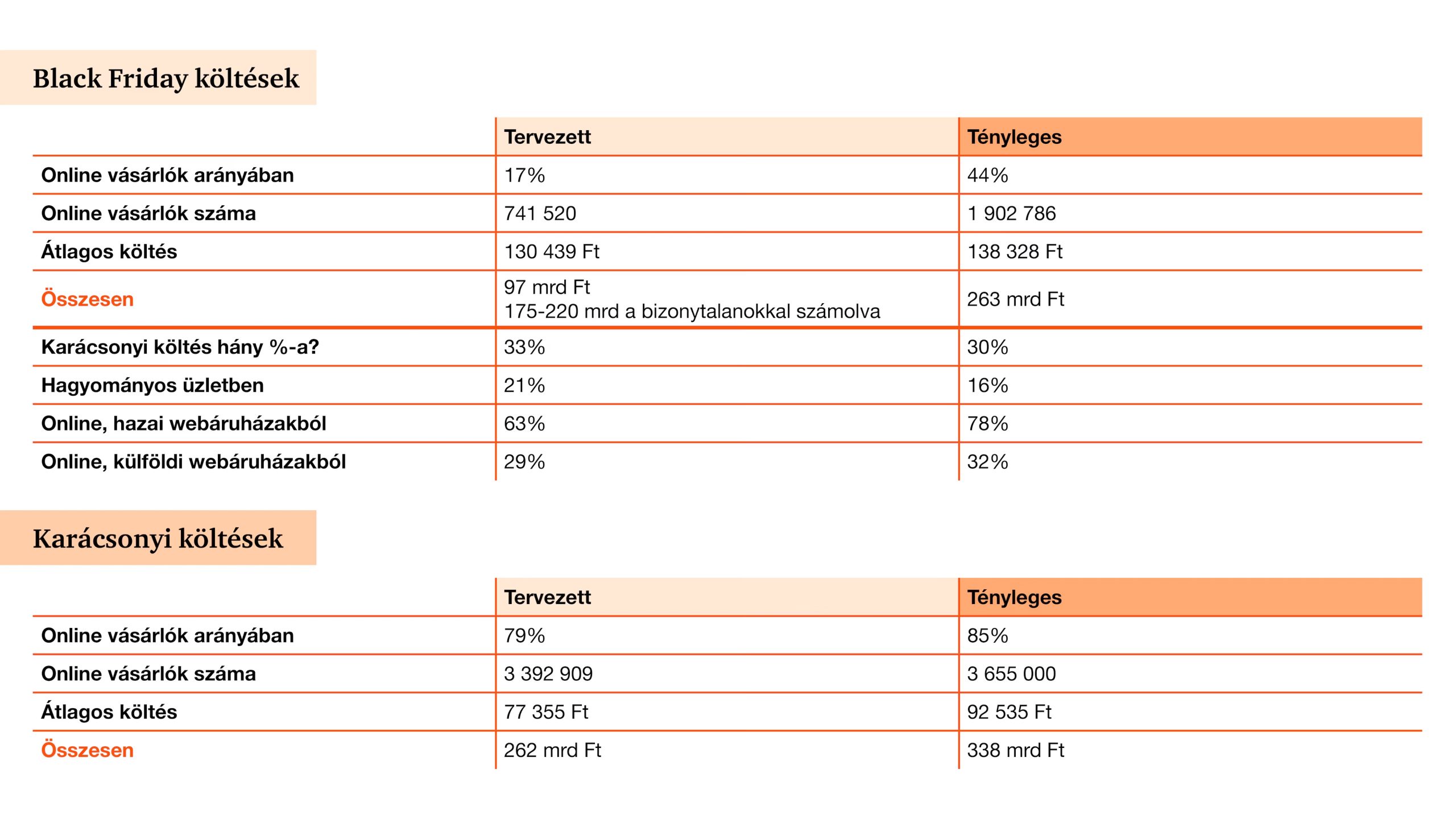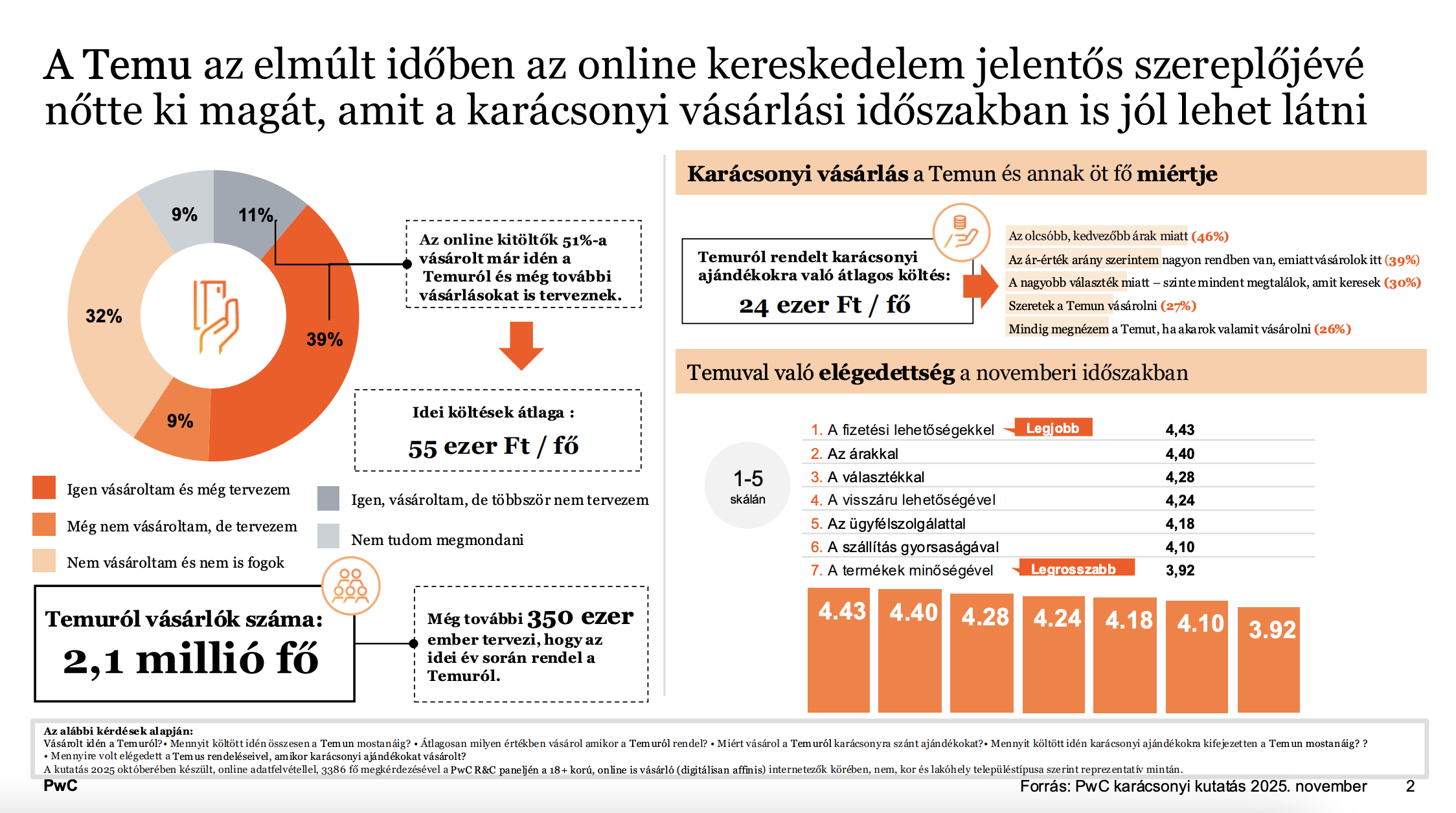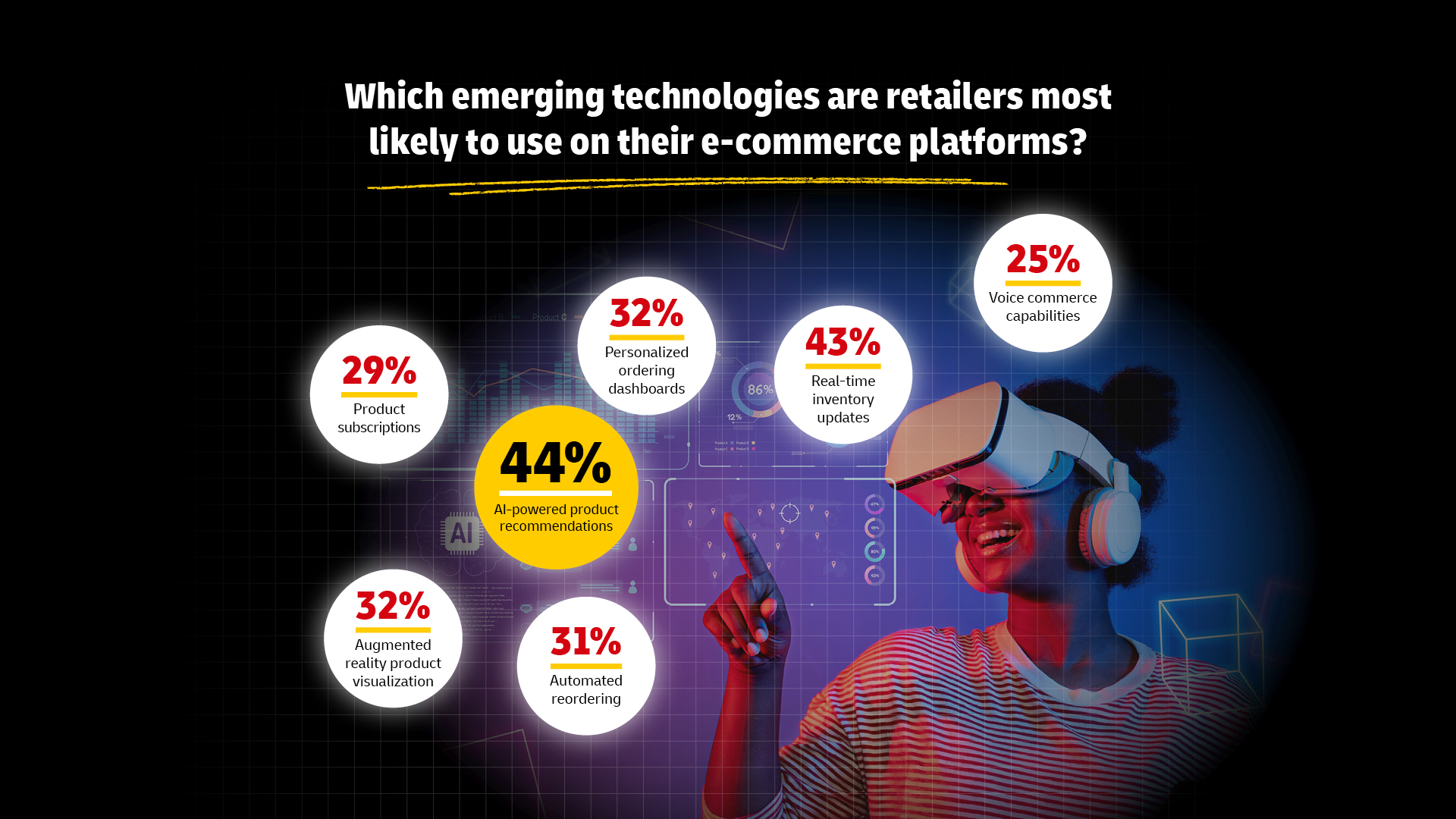How the top 50 Online Exporters in the CEE region perform? - report by Growww Digital The "Top 50 Online Exporters in the CEE Region" report by Growww Digital analyzes the performance of e-commerce exporters in Central and Eastern Europe. While the sector experienced...

Rekorddöntő Black Friday
Az akciók ereje: Hogyan lett a bizonytalanságból rekordköltés?
A magyarok idén bátrabban nyúltak a pénztárcájukhoz: a Black Friday és a karácsonyi vásárlási szezon a visszafogott előzetes becsléseket jóval túlszárnyalta, és a költések volumene elérte a 260 milliárd forintot. A PwC Magyarország októberi és novemberi lakossági kutatása szerint az online vásárlók stabilabbnak érzik jövedelmi helyzetüket és egyre tudatosabbak – 67% az akciók és kedvezmények alapján veszi meg a karácsonyi ajándékot, és az ünnepi költések mértéke elérheti a 340 milliárd forintot.
A Black Friday akciók idén felülmúlták az előzetes várakozásokat: a PwC október végi kutatásában előrejelzett 17%-hoz képest az online vásárlók 44%-a, mintegy 1,9 millió fő vásárolt a Black Friday (BF) időszak akcióiban. A magas szám azt jelzi, hogy az előzetesen bizonytalanok köréből sokakat sikerült megszólítani egy-egy jó ajánlattal. Miközben a realizált és a tervezett fejenkénti költés – 138 ezer és 130 ezer forint – nem tér el érdemben egymástól, a vásárlók tényleges száma végül jóval nagyobb vásárlási összeget eredményezett: az online költés elérte a 260 milliárd forintot (az előzetesen becsült 175-220 milliárdhoz képest).
„A kiemelkedő részvétel mögött az idei, valóban kedvező akciók állnak, amelyek sokakat ösztönöztek vásárlásra. Másrészt az év közbeni óvatosabb költést felváltotta a bátrabb vásárlás. Ez a két tényező együtt jelentősen hozzájárult ahhoz, hogy az előzetes várakozásokat ilyen mértékben túlszárnyalják a Black Friday-költések”
– mutatott rá Timár Szabolcs, a PwC Magyarország szenior menedzsere, a kutatás vezetője.
A vásárlók 55%-a olyan terméket vett saját részre, amelyet egyébként is megvásárolt volna, de most olcsóbban jutott hozzá. 48% karácsonyi ajándékot is vásárolt, sőt, a karácsonyi ajándékok 30%-a már a BF-időszak alatt került a kosarakba. Ez arra utal, hogy a fogyasztók egyre tudatosabban használják ki az akciós időszakokat az ünnepi készülődés során.
„Az online vásárlás tovább erősödött, a külföldi webáruházak szerepe is nőtt, miközben a fizikai boltok háttérbe szorultak. A vásárlók tudatosabbá váltak, jobban kihasználják az akciókat, és egyre többen tervezik előre az ünnepi költéseket”
– hívta fel a figyelmet a Timár Szabolcs.
- Az online vásárlók 78%-a hazai webáruházat választott, de minden harmadik vásárló külföldi webshopból is rendelt.
- A hagyományos boltok szerepe visszaszorult: mindössze 16% vásárolt BF-akció keretében fizikai üzletben.
- A legnépszerűbb termékkategóriák a műszaki cikkek (39%), ezen belül is az okostelefonok és tartozékaik, de a ruházati termékek (25%), smink (17%), játékok és könyvek (14-14%) is előkelő helyen szerepeltek.
- A vásárlói elégedettség magas, ötfokú skálán 4,14-es értéket ért el.
A karácsonyi költések is meghaladják a korábbi várakozásokat
A kutatás szerint az online vásárlók 85%-a, azaz 3,67 millió fő tervez ajándékvásárlást karácsonyra, átlagosan fejenként közel 6 főt ajándékoznak meg. Egy ajándékra csaknem 16 ezer forintot szánnak, így a fejenkénti költés eléri a 92,5 ezer forintot, ami összesen 340 milliárd forintos karácsonyi ajándékpiacot jelent – ez is jóval meghaladja az októberi, 260 milliárd forintra becsült összeget, illetve a tavalyi, 261 milliárd forintos előzetes számításokat is. A növekedés mögött az átlagos költés csaknem 15 ezer forinttal magasabb értéke és a végül ajándékot vásárlók körének 6 százalékponttal történt bővülése áll.
A vásárlási helyek között továbbra is a hazai internetes boltok vezetnek (64%), de a bevásárlóközpontok (43%), a hagyományos boltok (36%) és a külföldi webshopok (25%) is jelentős szerepet kapnak. A karácsonyi ajándék vásárlásakor legfontosabb döntési szempont az ár, akciók és kedvezmények (67%), de a kényelem (36%), a megbízhatóság (48%) és a termékválaszték (42%) is meghatározó tényezők. A fenntarthatóság és a hazai vállalkozások támogatása egyelőre kevésbé hangsúlyos (7% és 13%).

Finomságok ajándékba
A karácsonyi ajándékok sikerlistáját továbbra is a műszaki cikkek (36%) vezetik, de a könyvek (31%), gyermekjátékok (27%), ruházati termékek (23%), smink- és parfümtermékek (19%) is népszerűek. Az ajándékozók 63%-a élelmiszer jellegű terméket is választ, leggyakrabban desszertkülönlegességet, csokoládét (29%), kávét (17%), bort vagy pezsgőt (17%), szaloncukrot (14%) és röviditalt (14%). Az ajándékkeret 24%-át, mintegy 81 milliárd forintot fordítanak élelmiszer jellegű ajándékokra, ami jól mutatja, hogy ezek a termékek egyre inkább a karácsonyi ünnepkör szerves részévé válnak.
„Az év eleji, gazdasági bizonytalansággal terhelt időszakban a háztartások visszafogottabb költési terveket fogalmaztak meg, sokan inkább megtakarításra törekedtek, és elhalasztották nagyobb kiadásaikat. Az év végére azonban az elhalasztott költések egy részét megvalósították, köszönhetően a valóban kedvező akcióknak, vonzó ajánlatoknak is, és a hagyományos üzletek helyett nagyobb hangsúly volt az online vásárláson. Ennek eredményeként a Black Friday és a karácsonyi vásárlási szezon költései az online kereskedelem területén egyaránt felülmúlták a korábban mérsékeltnek tekinthető várakozásokat”
– foglalta össze a kutatás tanulságait Cserjés-Kopándi Ildikó, a PwC Magyarország e-kereskedelmi csapatának vezető menedzsere.
A forgalom-növekedés azonban nem egyenletes: azok a webáruházak tudtak jelentős részesedést kihasítani a forgalomból, akik a kedvező árak mellé magasabb szolgáltatási színvonalat is biztosítanak, mint például a gyors szállítás vagy épp a meghosszabbított visszaküldés lehetősége.
Top 50 CEE Online Exporters 2024
Digitális Kereskedelmi Körkép 2024/II.
A hazai e-kereskedelmi piac 2024-ben olyan átalakuláson ment keresztül, amelyre 25 éves fennállása óta még nem volt példa 2024-ben a teljes magyar e-kereskedelmi piac a PwC Q1-Q3 közötti mérései és Q4-re vonatkozó előzetes adatai alapján 15%-os árbevétel-növekedés...
Új lendület a digitális kereskedelemben
Megújult a Digitális Kereskedelmi Szövetség vezetősége Az átalakulás célja, hogy a szövetség hatékonyabban reagáljon a digitális kereskedelem előtt álló kihívásokra, elősegítse a hazai szereplők megerősödését és az exporttevékenység fellendülését. A Szövetség...
Rekorddöntő Black Friday
Az akciók ereje: Hogyan lett a bizonytalanságból rekordköltés? A magyarok idén bátrabban nyúltak a pénztárcájukhoz: a Black Friday és a karácsonyi vásárlási szezon a visszafogott előzetes becsléseket jóval túlszárnyalta, és a költések volumene elérte a 260 milliárd...
PwC karácsonyi kutatás 2025
Mennyit költünk idén karácsonyra? Rekordösszegek és új vásárlói szokások az idei Black Friday-en A korábbi évekkel ellentétben a Black Friday már nem csak egyetlen novemberi napból áll, hanem egy több napon-héten át tartó akciósorozattal bombázzák a fogyasztókat. A...
DHL 2025 E-Commerce Trends Reports
A DHL bemutatta az első globális e-kereskedelmi üzleti jelentését: AI, social commerce és a fenntarthatóság vezetik a 2025-ös trendeket A riport exkluzív betekintést nyújt abba, hogyan értékesítenek, növekednek és boldogulnak a vállalatok a gyorsan változó digitális...
DHL 2025 E-Commerce Trends Reports
DHL unveils first global e-commerce business report: AI, social commerce & sustainability lead 2025 trends The report offers an exclusive look at how companies are selling, scaling, and succeeding in today's rapidly evolving digital landscape, driven by...
HungarEcomm Stars 2025
Who are the most Globally Competitive Hungarian Webshops in 2025? A narrow elite is setting the pace in Hungarian e-commerce: for the second time, the HungarEcomm Stars Award has been presented to companies that are not only successful locally but also capable of...
HungarEcomm Stars 2025
Ezek a legvilágpiacképesebb magyar webshopok 2025-ben Szűk élboly diktálja a tempót a magyar e-kereskedelemben: második alkalommal adták át a HungarEcomm Stars Díjat azoknak a vállalatoknak, amelyek nemcsak itthon, hanem a nemzetközi színtéren is képesek versenytársa...


















